Creating content for Instagram takes a significant amount of time, especially if you intend to post frequently.
Connecting Instagram to Google Data Studio can be difficult, particularly for beginners. In this blog post, you’ll learn how to create a Instagram Report on Google Data Studio!
In case you want a quick answer, it’s easy! Connect your Instagram to Google Data Studio…
However, keep reading if you want the complete tutorial and get free Instagram templates (valued at 400$) while at it.
By the end of this tutorial, you will not only have your Instagram report in Google Looker Studio, but you will also have professional reports without any hassle.
You can request our support team to set up your first Instagram report for free by scheduling a call here (no sales pitch).

Before you begin
If you know Google Data Studio and want to start immediately, I suggest you download one of our free Linkedin Pages Templates.
To link your Instagram to Google Looker Studio, you will need the following:
- A Google account.
- A Linkedin account.
- A Looker Studio account
You can also check out this video for a step-by-step connection of Linkedin to Looker Studio.
Connecting Instagram and Creating a Report on Looker Studio
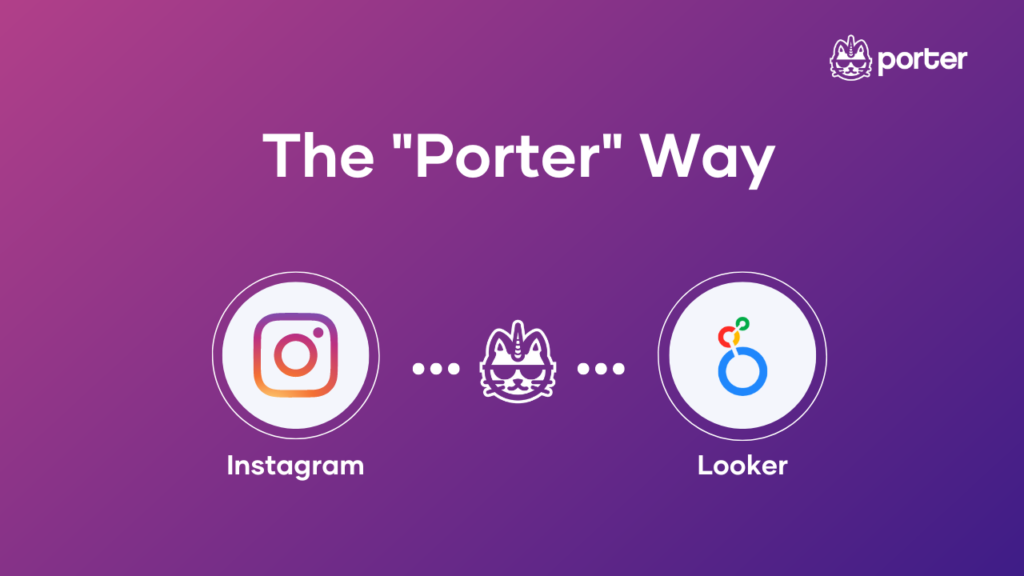
There are two ways to connect and create an Instagram report on Looker Studio.
You can create reports on Data Studio using CSV files or a connector. Although the CSV files method is free, the process is long and meandering. However, using a connector makes it easy and straightforward.
We have a tutorial on How to Connect Facebook Ads to Google Data Studio, which you can read here.
With our Facebook connector, we have helped +3,000 marketers to connect their Facebook Ads Data with Google Data Studio. Here are the steps we will follow:
- Learn how to set up a Google Data Studio account
- Facebook Ads connector for Google Data Studio: connect your accounts
- Explore our Facebook Ads templates for Google Data Studio
- Understanding Facebook Ads metrics
- Creating your first reports
- Facebook Ads dashboards templates with Data Studio
Connecting your Instagram to Google Data Studio
- Go to the Porter Metrics website, and click on “Make a Report”
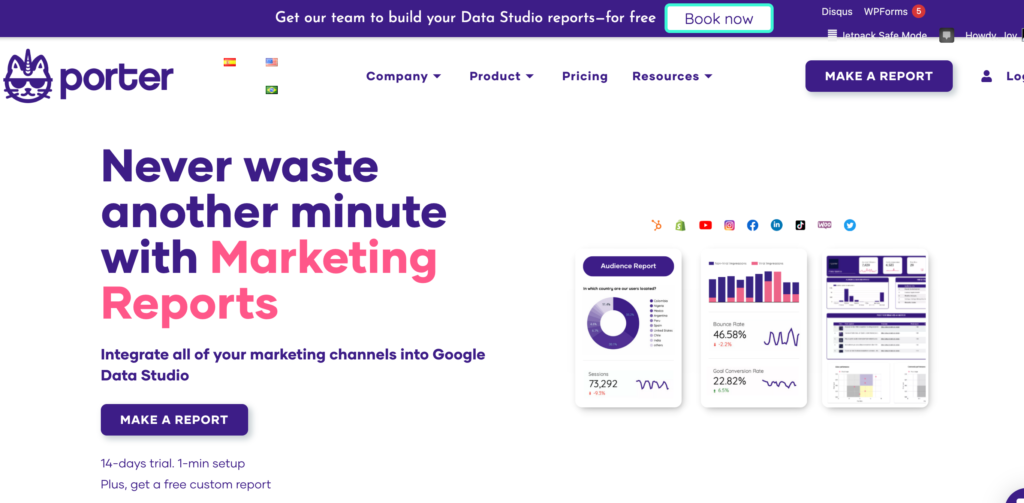
- Click on the “Instagram” Connector
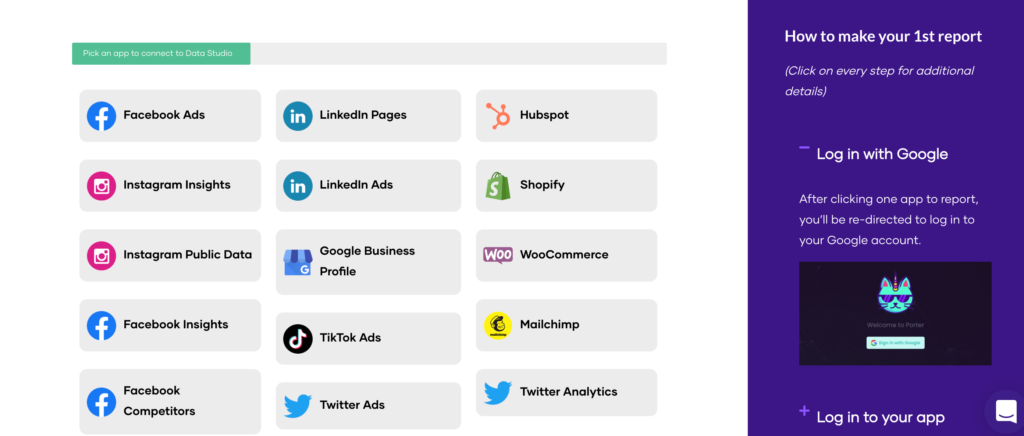
- You will be redirected to Looker Studio. Click on “Authorize”
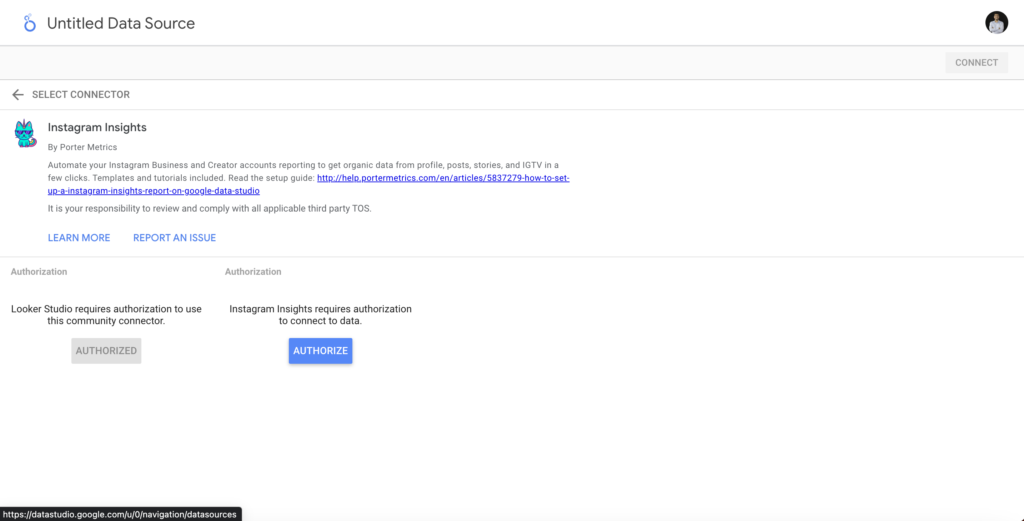
- Click on your Instagram account and click on “Choose your Instagram Account”
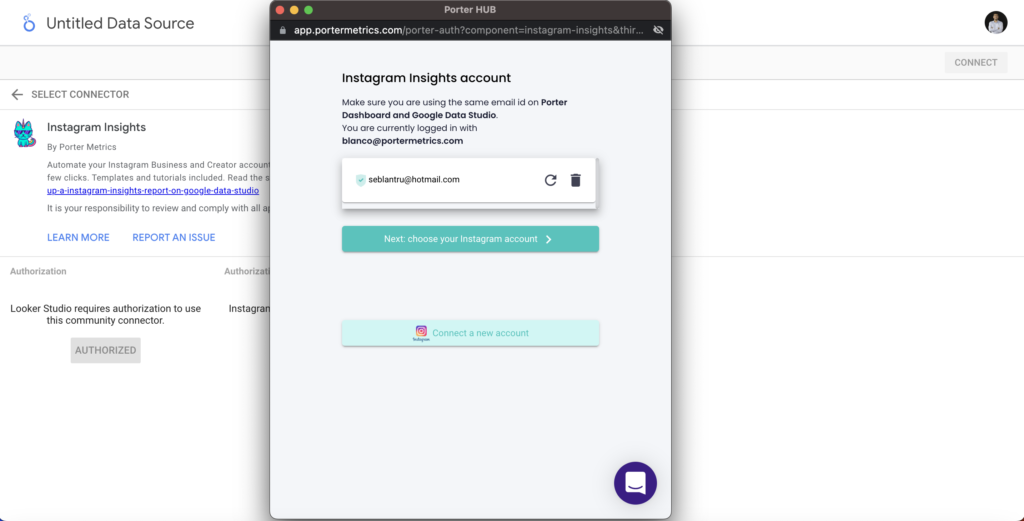
- Sign up for (login to) Porter with your email
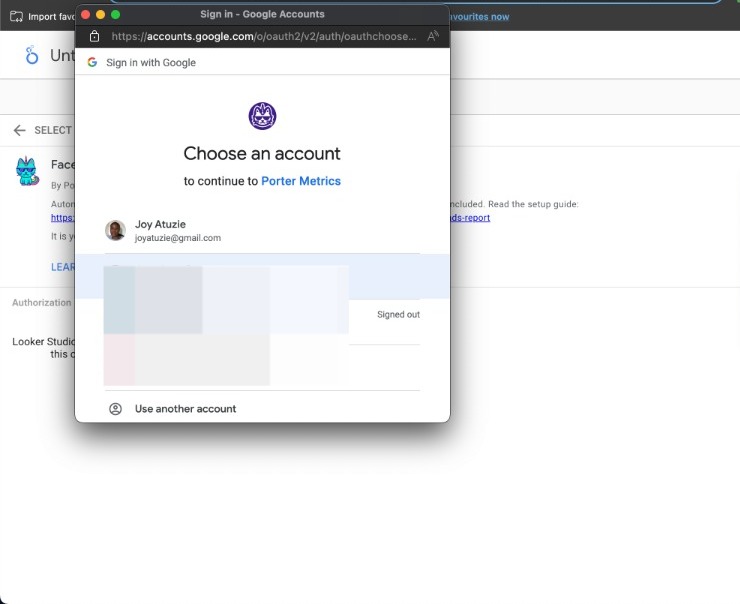
- Congratulations! You have now connected your Instagram data to Data Studio.
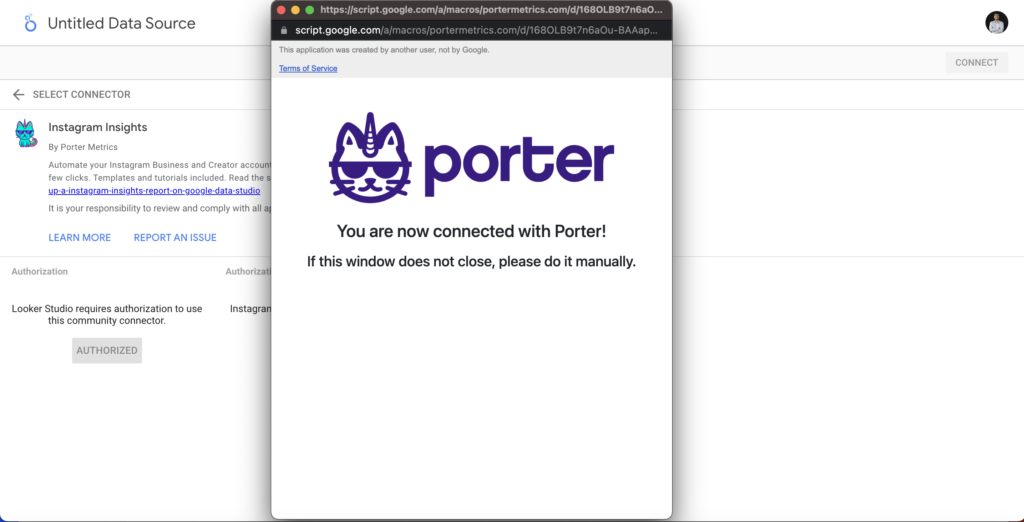
Setting up the connector
Now, its time to set up your Instagram account using the Porter Metrics connector.
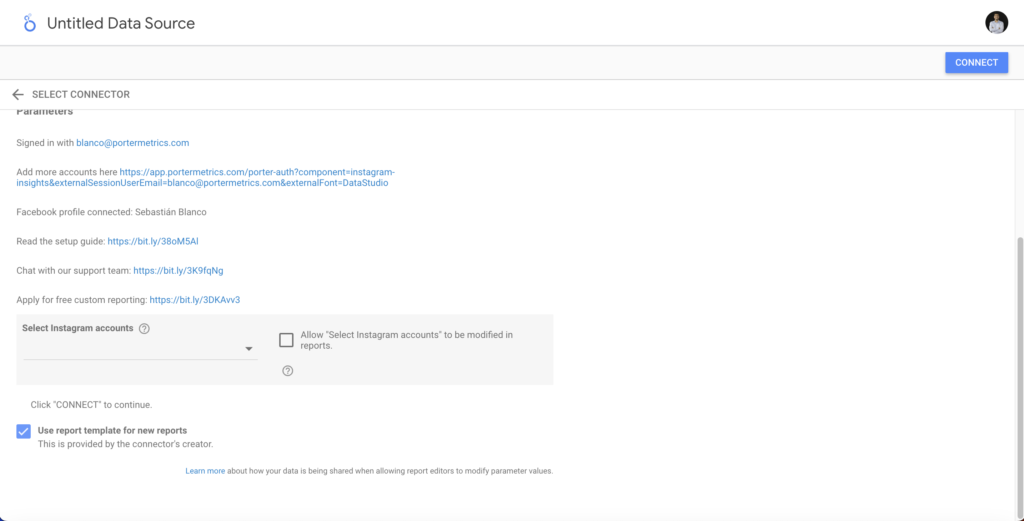
- Select the Ad accounts you want to connect and check the following boxes
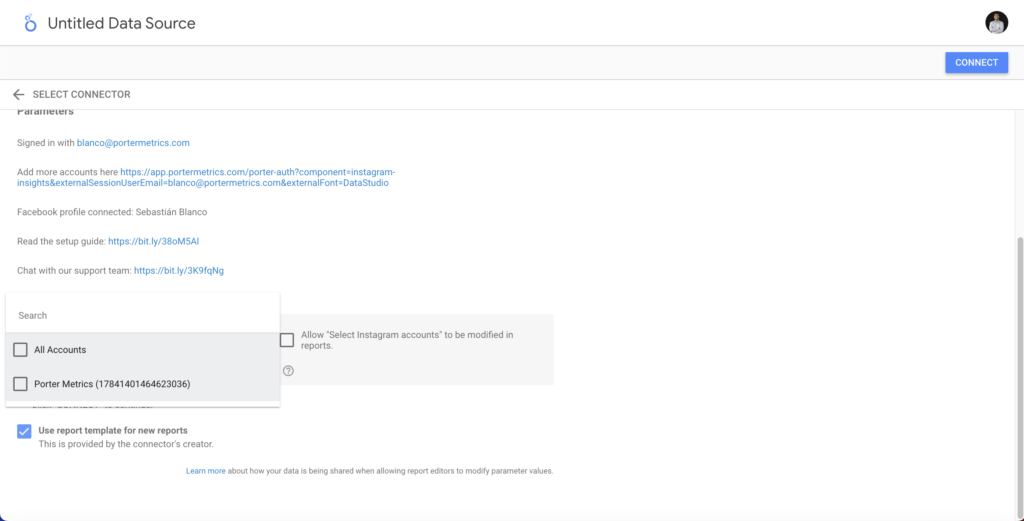
- Once you’re redirected to this page, click on “Create Report” at the top of the page

- Once this pops-up on your screen. Click on “Create Report”
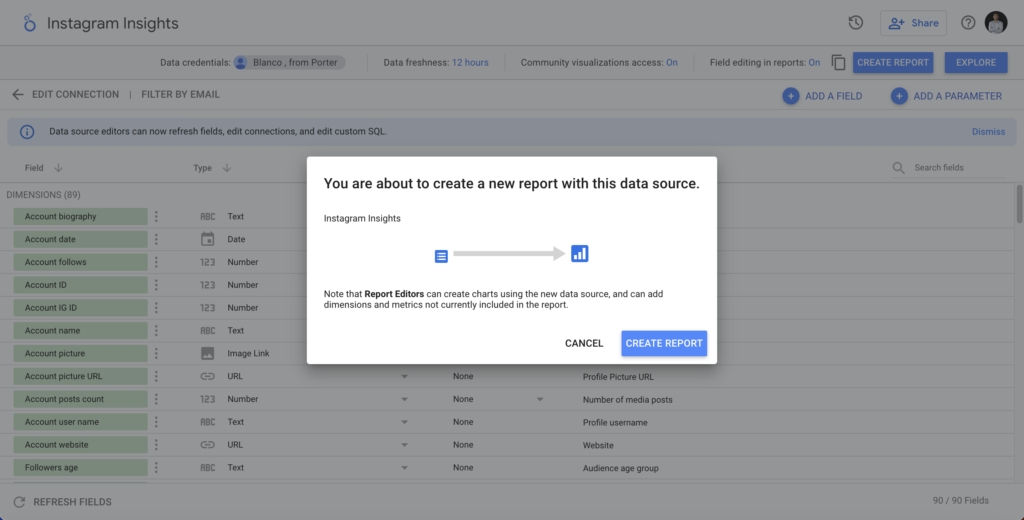
Enjoy your first report!
Finally, we’ve come to the end of this tutorial. You will be redirected to our free template page on Looker Studio.
- Navigate to the “Overview” page, and toggle the dates to show recent data.

Understanding Instagram Metrics & Dimensions
We can set up our Instagram pages report on Google Data Studio by navigating all its fields, metrics, and dimensions available.
We see Google Data Studio as a canvas where you drop any type of chart, combining any metrics and dimensions.
The metrics are the numerical values, like followers, reach, and engagements; dimensions are how you break down the metrics, like by date, country, post, etc.
If it’s your very first time with Data Studio, I would recommend you to check this resource to create your first Google Data Studio report.
To help you navigate the Instagram metrics, I recommend watching this tutorial on creating charts and graphs.
One of the limitations of Instagram Insights reporting is that you should combine related metrics and fields.
You can only combine post dimensions with post metrics, like Post image with Post likes, but you cannot combine account dimensions with post metrics, like Account name and post shares.
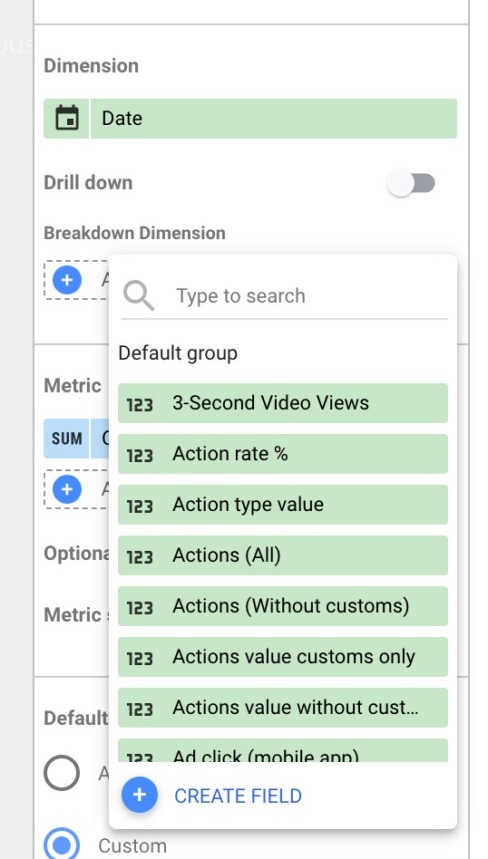
Instagram account dimensions
The account-related dimensions on the LinkedIn Ads connector have fixed values; they don’t change over time. They are:
- Account biography
- Account ID
- Account IG ID
- Account name
- Account user name
- Account website
- Account posts count
- Account total followers
I just created a table within our Data Studio report to show all these account-related fields:

With this, you don’t need to add the logo manually for every report template you copy on Data Studio. Nice, huh?
As you can see, I’m bringing 6 Instagram pages in a single data source. This use case is great for agencies or companies with multiple brands to monitor all their Instagram pages in one view.
A good practice, for example, is that you can display the ad account profile photo.
Instagram profile metrics
You can also bring profile engagement metrics that can track over time such as:
- Taps on website link
- Taps on phone link
- Taps on directions link
- Taps on text message link
- Taps on email link
- Profile views
- Profile new followers: Instagram will let you only get the latest 28 days of profile new followers data (Unless the data is stored somewhere, like Google Sheets).

Instagram post metrics and dimensions
One of the coolest things about Google Data Studio is that you can display images. This connector can display the ad creatives and see which one performs better.
Clients and non-technical users may understand the names you put to your campaigns, but they will love the visuals.
Sometimes, the images displayed on Google Data Studio seem blurry. The reason is that Data Studio doesn’t create images but brings them from a URL.
Sometimes, the images are too small (aka thumbnails), so you will affect their quality if you increase the size.
I recommend keeping them as small in their tables’ columns as possible. The Instagram pages Insights connector for Data Studio lets you bring post dimensions like:
- Post image
- Post caption
- Post type: if your post is video, carousel, image, etc.
- Post link: a clickable link to access the post on Instagram
- Post date: the date when the post was published
- Post hour of day: the hour of the day when the post was published
- Post first 3 comments: displays the first 3 comments users did on a post
The post metrics are:
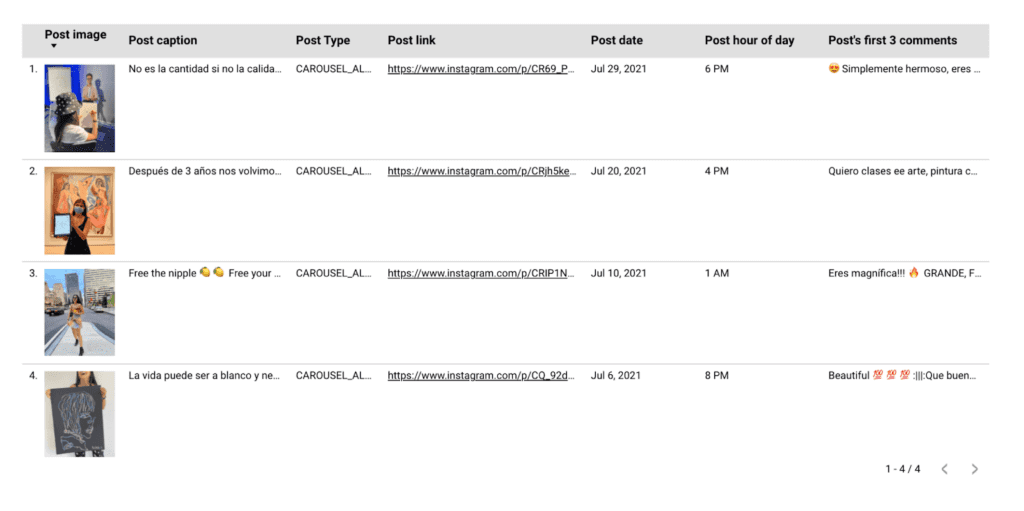
- Post saves
- Post reach
- Post likes
- Post impressions
- Post video views
- Post engagement
- Post comments count
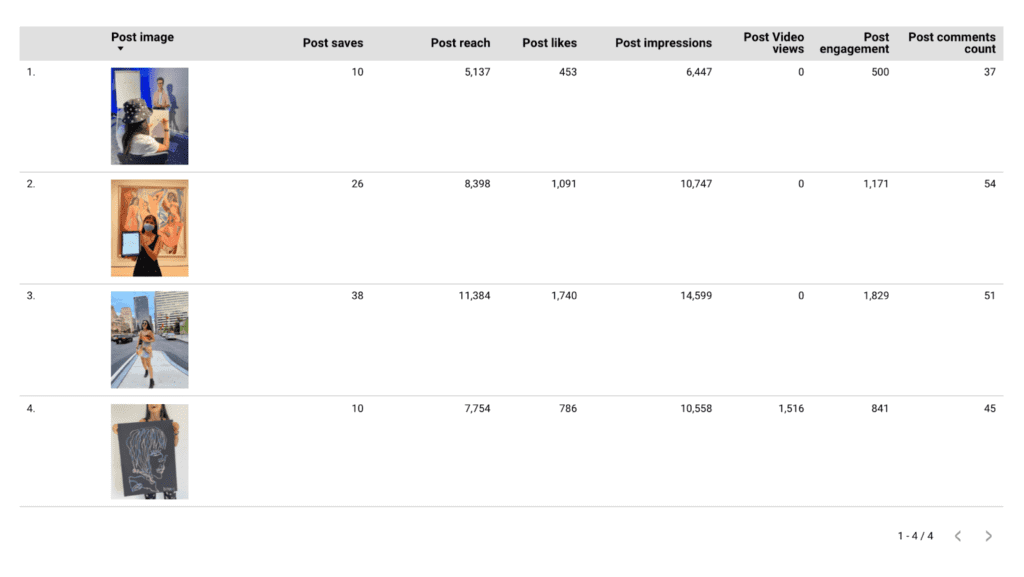
The field Post sends is not currently available in the Instagram API.* With the Post type dimension, you can filter reports for Instagram carousels.
Remember to only combine post fields among them; if you use Profile date as the time dimension and combine it with Post metrics, the chart will break.
Instagram audience metrics
With Instagram data, you can know who interacts with your posts and profile. The fields include:
- Country: combine Audience country (dimension) with Audience for countries (metric)
- Age: Combine Audience age groups (Dimension) with Audience age groups quantity (Metric)
- Gender: Combine Audience gender groups (Dimension) with Audience gender groups quantity (Metric)

Instagram stories metrics
Most Data Studio connector providers don’t offer Instagram stories because the Instagram API only stores stories data for 24 hours.
Porter automatically stores this data; you can only bring Instagram stories when you connect to Porter. Before that, there’s no way to retrieve data.
To get Instagram story reports your provider should have a storage feature; Porter is a no-code solution, but most offer data warehousing such as Big Query and Red Shift.
The metrics include:
- Stories replies
- Stories taps (backward)
- Stories taps (forward)
Customizing your Instagram Report
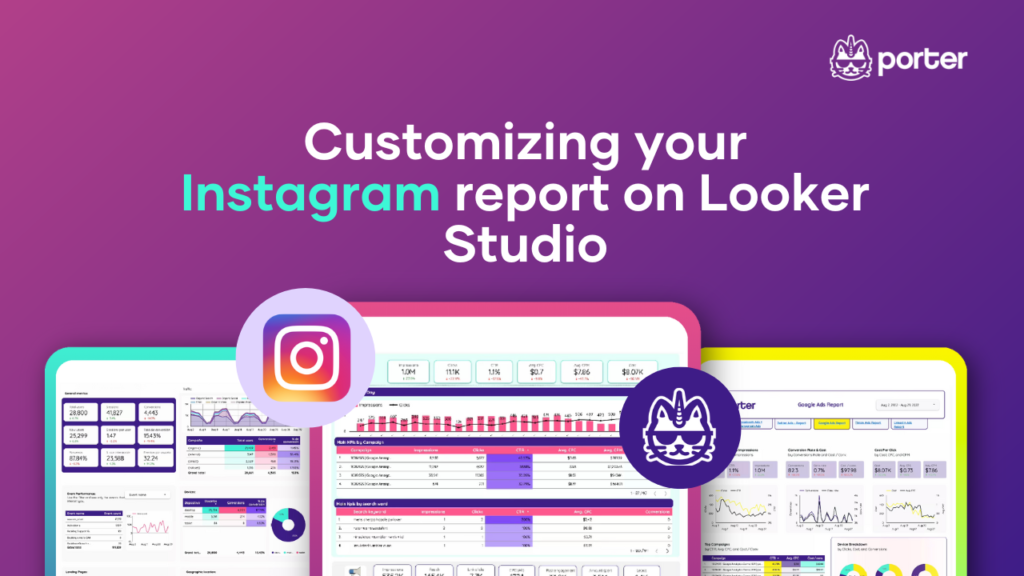
Making better data-driven decisions is possible with the help of Google Data Studio, a potent data visualization tool. Despite having many features, one of its best qualities is that it can be customized.
Google Data Studio can be used to create a report that is specific to your requirements. You can use the FREE templates at Portermetrics to create your marketing reports if you detest creating data studio reports from scratch.
Yes, you can alter these templates to meet your specific requirements. We prepared a video tutorial showing how to customize your Instagram reports (and make them Whitelabel).
You can also check out this post on How to Customize your Google Data Studio Report. Let’s get right into the topic without further ado.
Themes
The theme and layout of the report are among the first things that can be customized when creating custom Data Studio reports.
You can apply and use 19 different themes from Data Studio for your reports. On the menu of your report dashboard, select “Theme and layout” to access them.
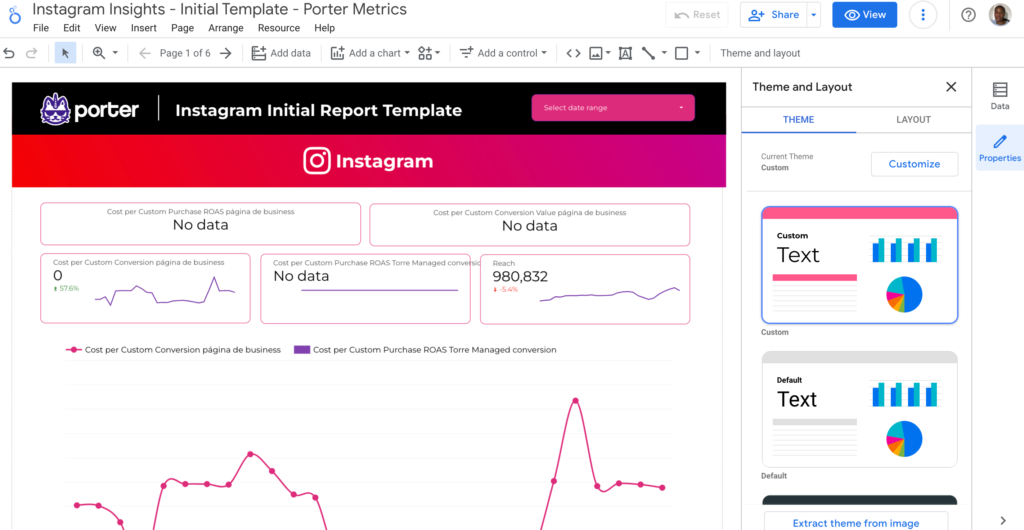
Editing current theme
You can choose specific colors for your reports thanks to this. Here, you can change the colors of your background, border, textbox, accent, and text.
You can also select the color for the different types of charts in the report.

Extracting Colour Theme From An Image
You can tailor your reports to match the brand colors on your website, which is one of data studio’s exciting features.
You don’t necessarily need to copy and paste color codes to use your brand colors in your reports.
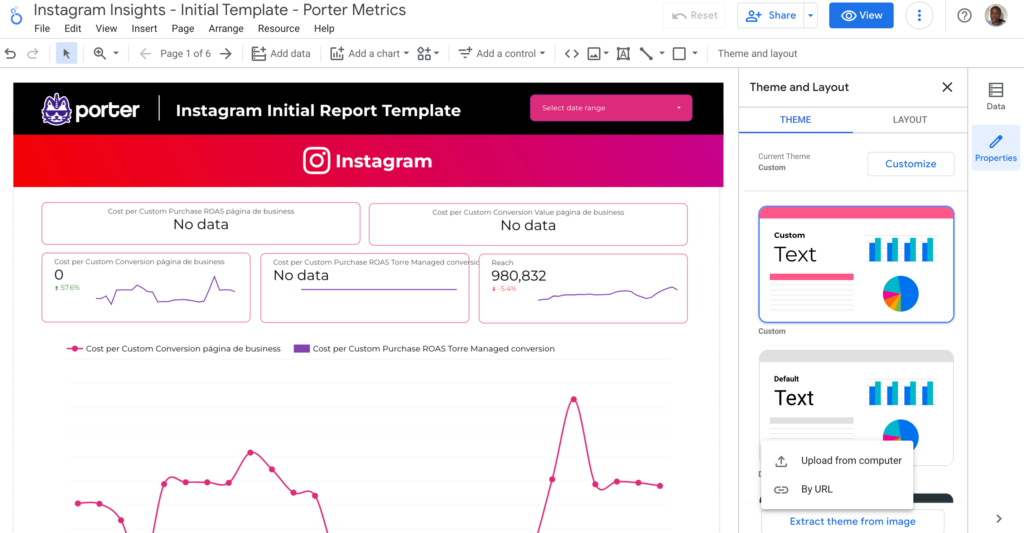
Layout Settings
By selecting “Layout” to the right of “Theme,” you can change the report’s layout.
View mode, canvas size, grid settings, and report level composite position are the four sections of the layout tab.
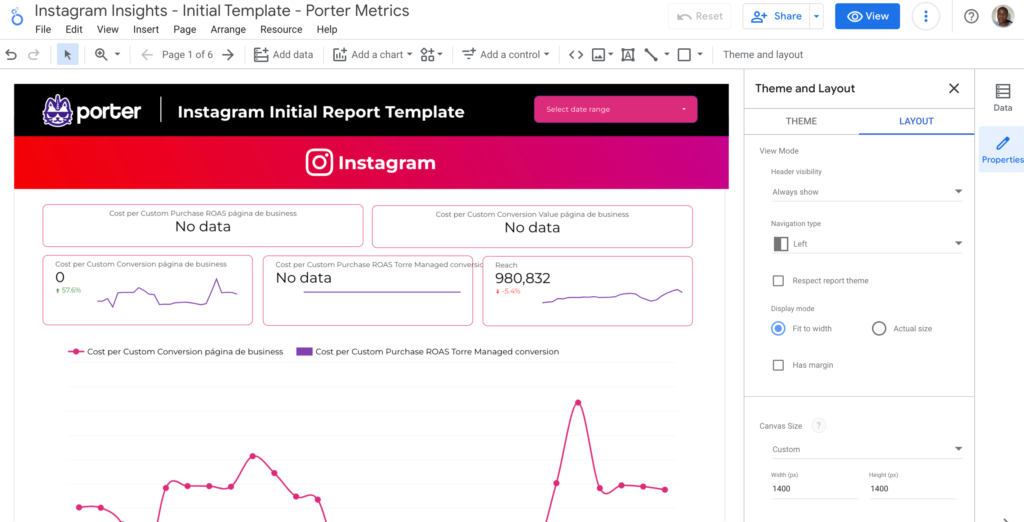
Grouping & Editing Your Report Pages on Data Studio
Since Google Data Studio dashboards serve as the users’ navigational framework, they significantly impact how data is visualized; as a result, grouping and editing your report pages is crucial.
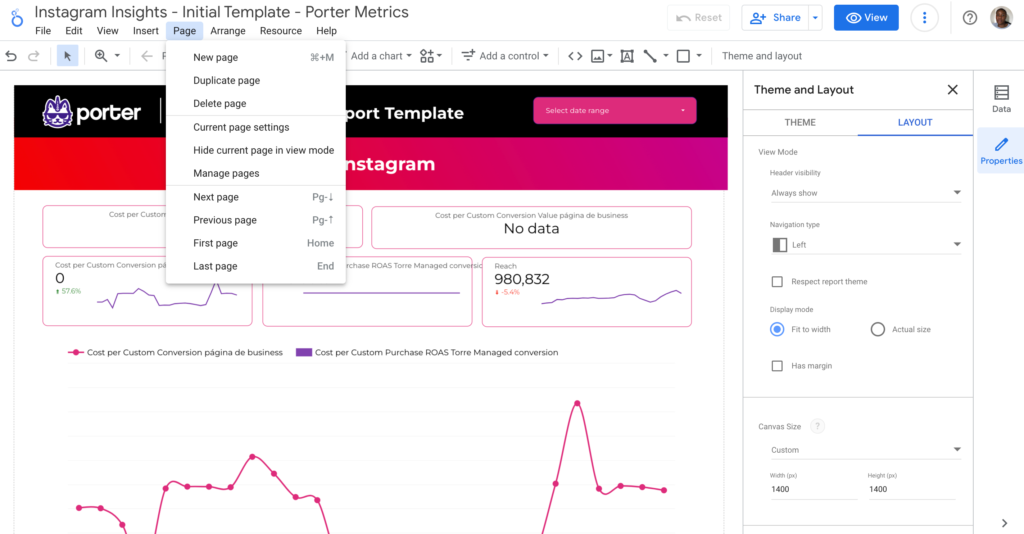
Adding your logo
Click on the image icon to upload your logo from your computer. You can also upload your logo by entering the URL of the logo.

Customizing the Report Banner
When creating reports with multiple pages, you’ll want some components from one page to appear throughout the report.
Depending on the type of report you’re creating, this could be your report header or banner, date ranges, charts, or time series.
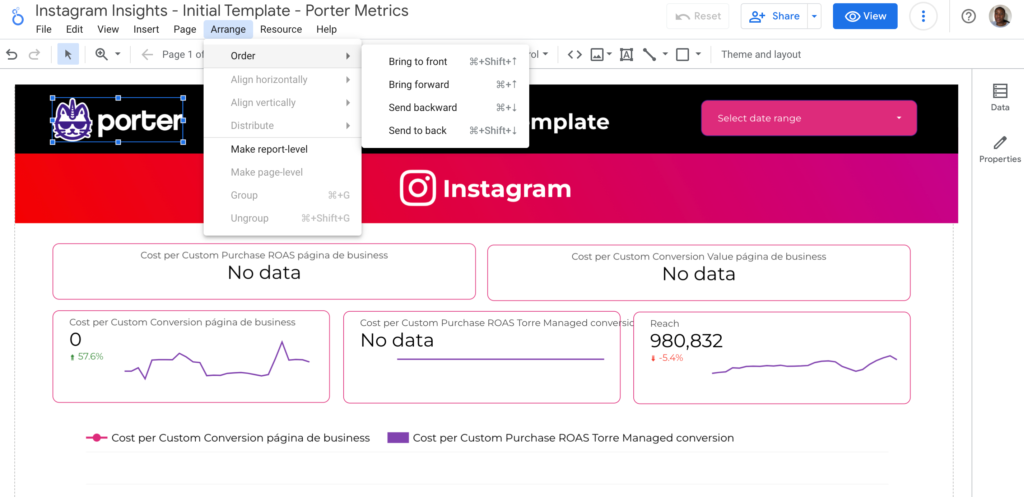
Styling your Looker Studio Reports
To further personalize your reports, Google Data Studio is flexible enough to let you style every aspect of your report.
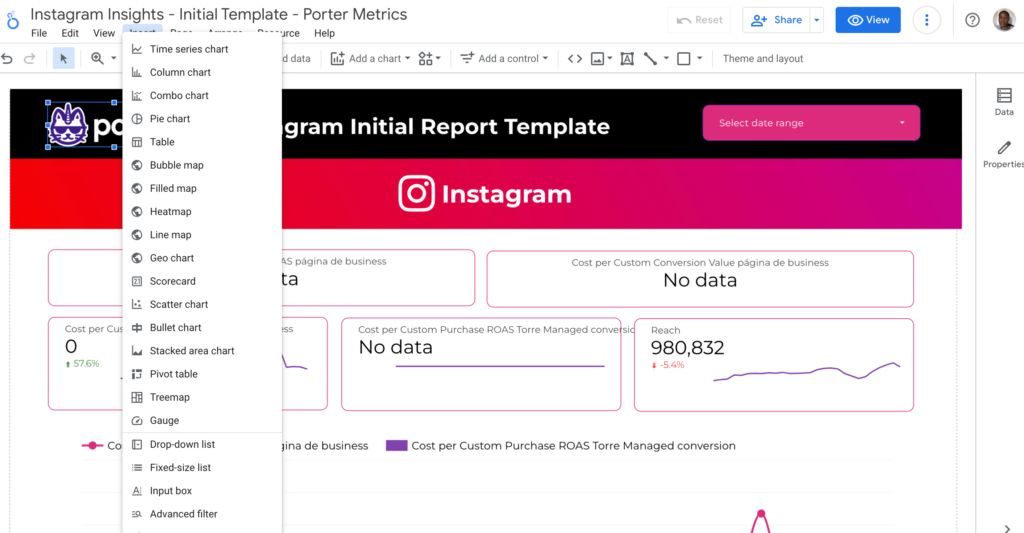
Styling Charts in Looker Studio
Charts are important components of reports. Google Data Studio does an excellent job of providing its users a wide range of options.
Tables, scorecards, time series, bar charts, pie charts, Google map charts, Geo charts, lines, area, scatter charts, pivot tables, bullet charts, treemaps, and Gauge charts can all be added to reports using Data Studio.
On the report dashboard, click “Add a chart” to access the various chart types in the data studio. This reveals the 14 chart types available in Google Data Studio.
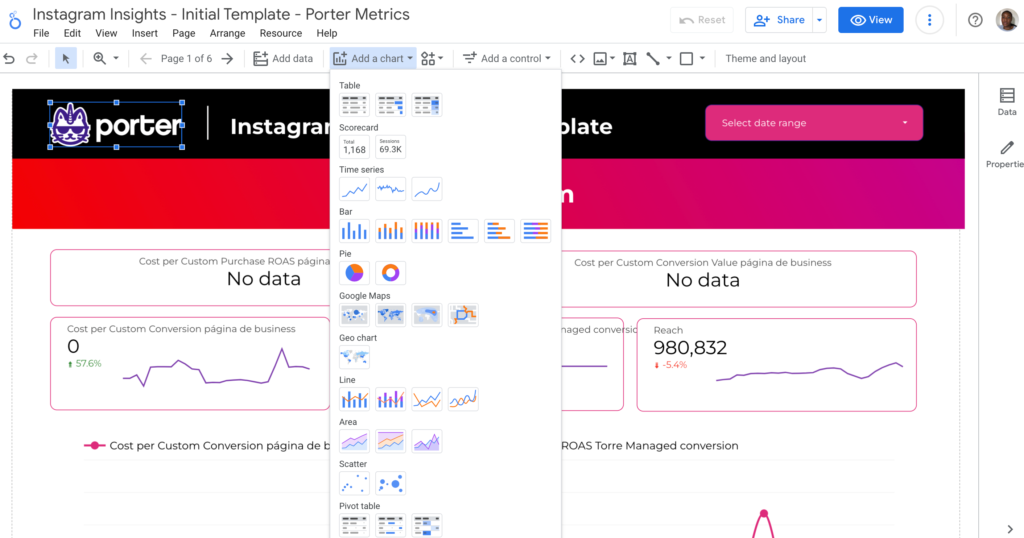
Check out this article for more details on How to Customize your Google Data Studio Report. Remember that you can always use a Porter Metric template to save time on your reports.
Sharing and Exporting your Instagram Report
Google Data Studio like other Google products, Google Data Studio has excellent collaboration and sharing features. Share your data stories with other members of your organization, clients, or the world.
You can find a summary of how you can share your reports in this section. We covered this topic in detail here; How to Share your Google Data Studio reports.
To share, view the asset you want to share, then select Share from the menu in the top right:
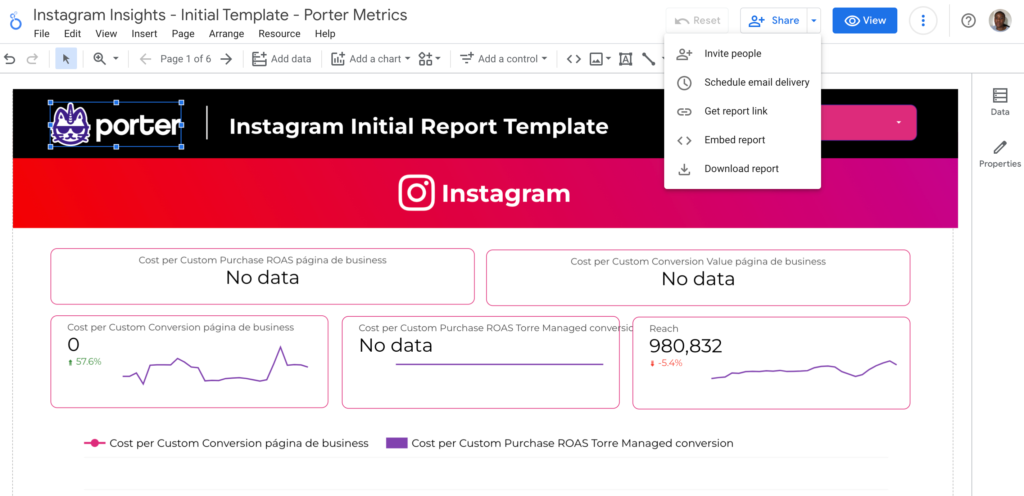
You can invite people to collaborate.
You can send viewing or editing invitations to specific individuals or Google Groups. Your Looker Studio assets are only accessible to those people or members of those groups.
By activating link sharing, you can also share information more widely. By doing this, anyone within your company or online—even those without a Google account—can view your Looker Studio assets.
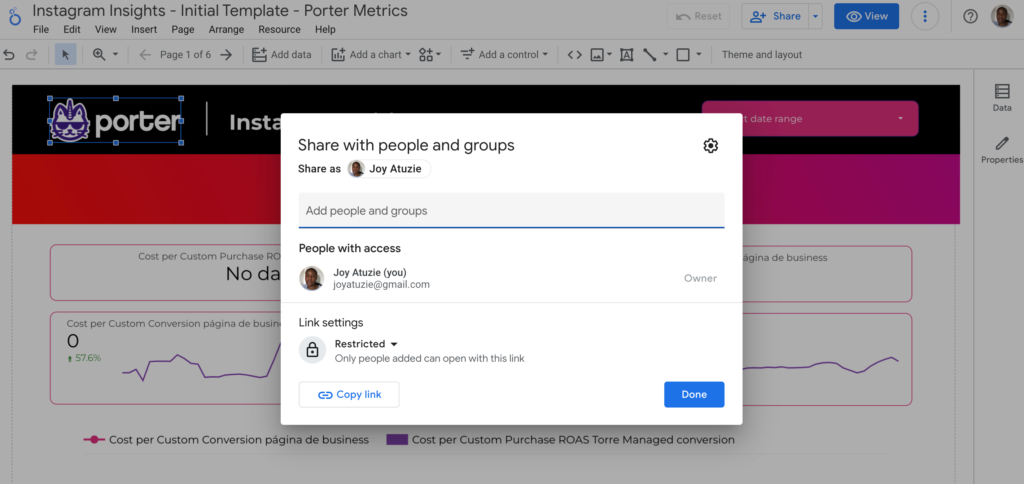
Share a link to access the report.
A short URL to a Looker Studio report can be created and shared, used in web pages, or used for any other purpose that links can be used for.
The report’s current settings, including filters and date ranges, may be included in the link. Understand how to obtain a report link.
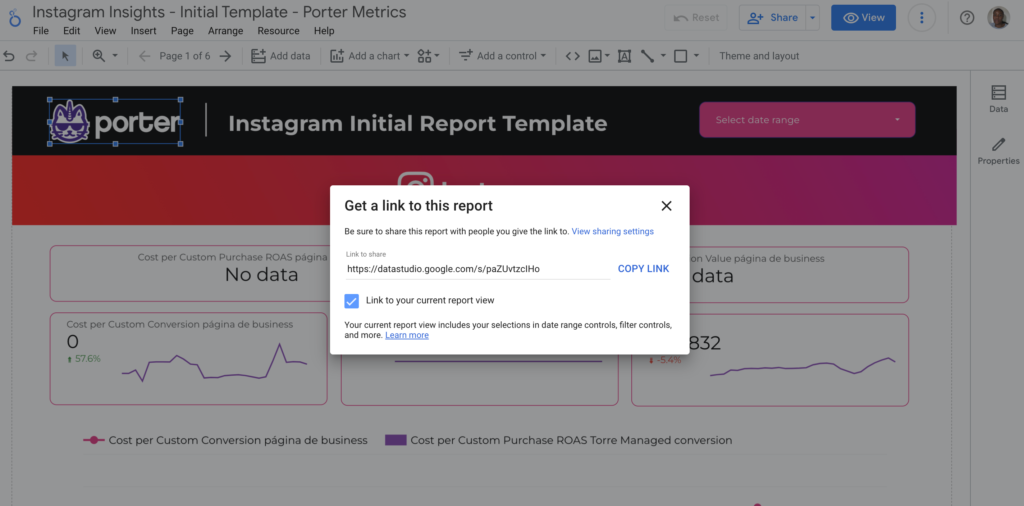
Schedule an automatic email delivery
By establishing an email delivery schedule, you can routinely send yourself and your stakeholders a PDF of your Looker Studio report.
This is perfect for monthly reports, as data is updated in real-time, and no time is lost in updating or sending.
Download a PDF version
Downloading your report as a PDF will allow you to save a copy of it. The file can then be printed, archived on disk, shared offline via email, and used in any way that PDF files can be used.
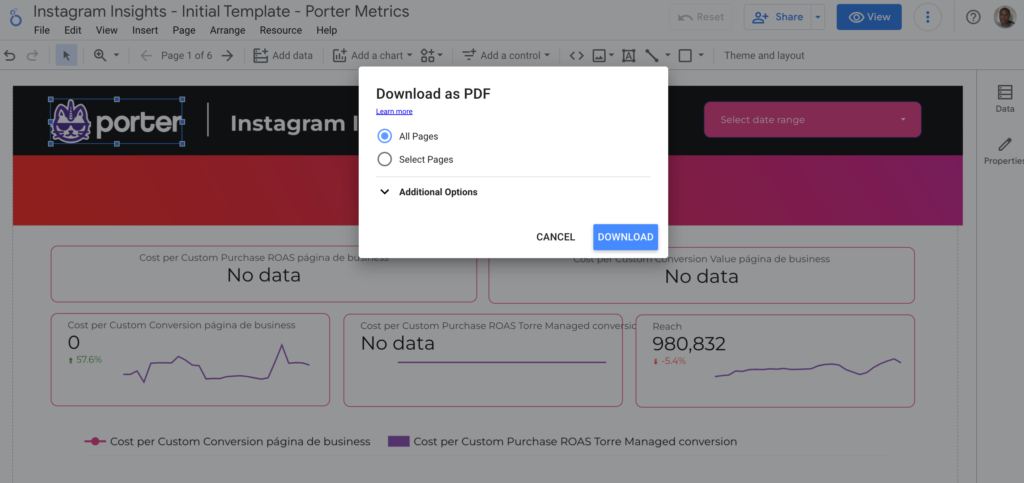
Embed the report
You can put your data stories into a wider context by embedding your reports. You can embed it into Google Sites or any other website that supports iframes.
Additionally, you can post your reports on websites that allow Embed links, like Reddit and Medium. Study up on embedding.
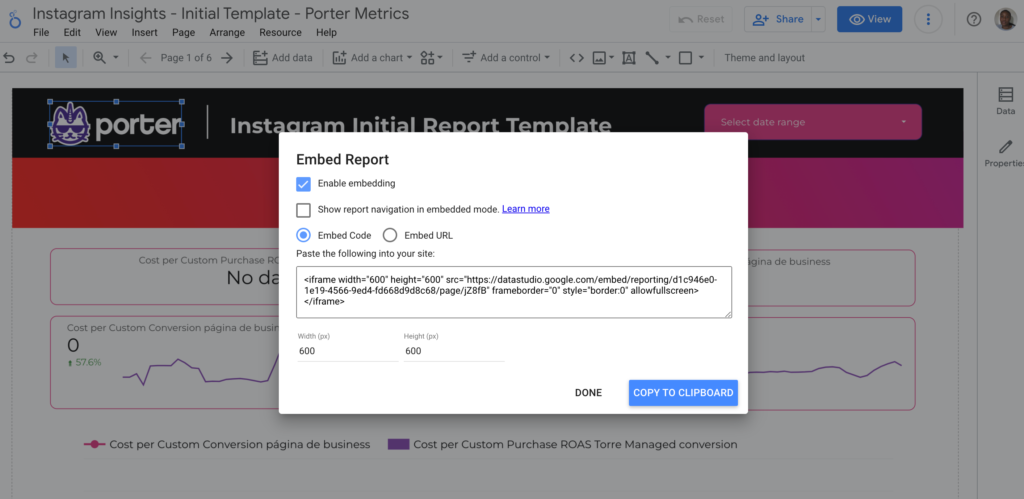
Share reports on social media
Reports from Looker Studio can be shared on social media sites like Facebook, Slack, LinkedIn, and Twitter as well as in chat programs like Hangouts and iMessage.
Ensure that others can view the report before pasting the link into the app. Find out more about social media sharing.

Conclusion
It’s ok if you don’t want to set up your Data Studio reports. We prepared a set of Instagram pages Google Data Studio report templates covering all the possible use cases so you don’t have to.
We have a tutorial on how to use Data Studio report templates, too. A common question is how you can add these templates to your current reports.
You need to select all the elements of your Data Studio report, copy, and paste them into your other reports.
We create new templates every week for free that you can find in our Google Data Studio Template Library.
We have templates for almost every use case: Instagram, Social Media, E-Commerce, Google Ads, and SEO. We have it all.
It is time for you to start building your own Instagram report! If you have specific questions write to me at support@portermetrics.com.

